What and how to feed the Decembrist?
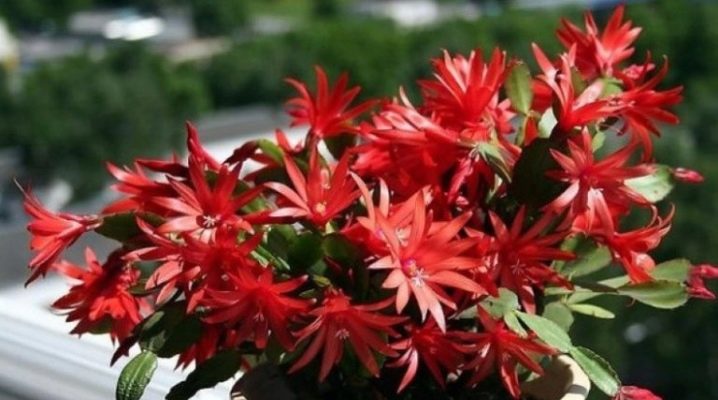
Outside the window are cold December days, and a bouquet of scarlet flowers is blooming in the room. Say, is this impossible? Not at all. Meet: the Decembrist, which got its name precisely for flowering in the winter season, when most plants are resting.
Description
The official name of the Decembrist is the Schlumberger zygocactus, which he received thanks to the French collector and biologist Frederic Schlumberg, who discovered this new species of forest cactus. "Schlumberger" is a southern inhabitant, its main habitat is the Brazilian subtropical forests. In its natural environment, the plant is in the constant shade of large fellows in a warm, humid microclimate. Hence the dislike for direct sunlight and the minimum requirements for the mineral composition of the soil. As a representative of the epiphytic, zygocactus loves to attach to other plants or trees.
In Brazil, you can observe an amazing sight when the Decembrists hang from the trees with a multicolored motley carpet. In this case, the zygocactus uses them rather as a support, and receives all the necessary nutrition with the help of thin air roots. A fairly compact root system with thin shoots located in the upper soil layers, used for easy attachment to the roots and trunks of trees.
At home, the flower feels great in a regular pot of soil.
The plant is a small bush with branched stems. The leaves are flat, segmented, covered with small denticles at the edges (not to be confused with needles). The length of the leaf is usually up to 5 cm. Flowering begins in November and lasts until January. The flowers are plentiful, multi-tiered, reaching a size of 6 cm or more. In nature, they are bright scarlet. Selection specimens can be of various shades: from soft cream to raspberry and spectacular lilac. The lifespan of each flower is very short: no more than 5 days.
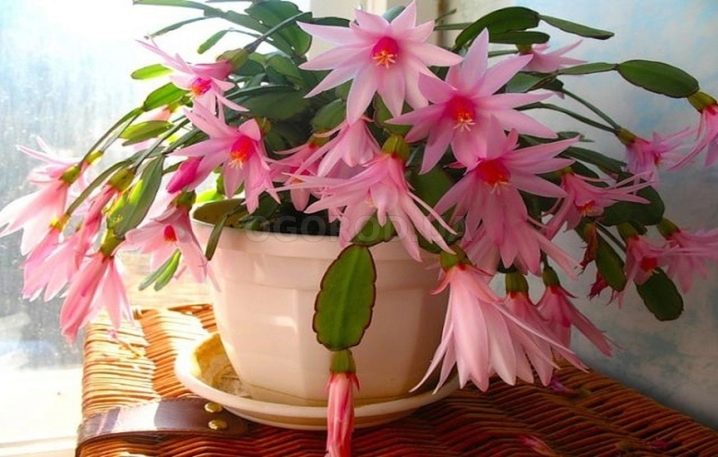
Care advice
Zygocactus is a recognized long-liver. With proper care and watering, it can live up to 20 years. Although the official name of the Decembrist contains the root "cactus", the rules for caring for a flower are somewhat different than for the traditional representatives of the Cactus family. Taking into account the peculiarities of the natural growing environment, florists have determined the basic recommendations for caring for a Christmas flower.
- The best location is east windows, where there is no bright sunlight, but at the same time there is a soft diffused light.
- The Christmas tree loves temperature stability. At the same time, he is completely non-capricious, resistant to coolness: he lives peacefully at a temperature of +10 and + 15 °. But still, the regime of + 18– + 25 ° will be ideal for flowering.
- In the warm season, it is advisable to take it out of the house or open the windows. Fresh air is good for the plant.
- Regular spraying will be useful. In summer - several times a week, in winter less often, 1-2 times a month is enough.
- When caring for a flower, it is necessary to maintain a moderate humidity. You can put "Schlumberger" on a tray with wet moss.
- It is necessary to observe the increased frequency of watering in the summer. After the onset of autumn and in December, immediately before budding, reduce the flow of moisture. In the spring, watering should be done as the soil dries up.
- With the formation of buds and active flowering, it is better not to disturb the zygocactus, not to change its location.
- In the spring-summer period, feed.
The last point is very important.
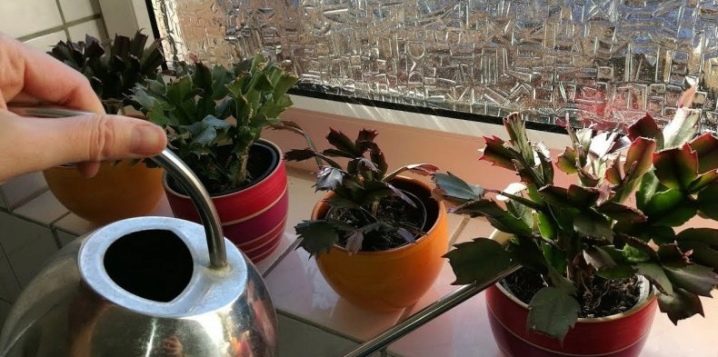
What is top dressing for?
The use of fertilizers, first of all, is necessary to replenish mineral salts that are washed out of the soil during irrigation. Due to its natural epiphytic qualities, the forest cactus does not impose increased requirements on the composition of the substrate. However, like any houseplant, it still needs periodic vitamin and mineral feeding for abundant and prolonged flowering.
Sometimes buds do not form on an outwardly healthy Decembrist. It is enough to add nutrients with potassium for it to bloom in a few weeks.
If the deficiency of minerals in the substrate is critically small, then the flower will signal with the following signs:
- slow growth;
- painful stems;
- small light green leaves;
- spots and yellowness on the leaves;
- lack of flowers in the autumn-winter period.
In this case, an urgent soil enrichment procedure is needed, otherwise the flower will simply die.
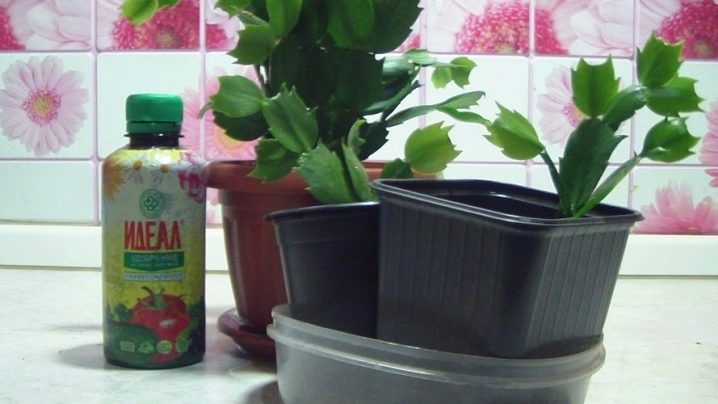
The right time
The time of feeding directly depends on the life cycle of the "Schlumberger", these cycles are very important to take into account. The most favorable period for soil enrichment will be the spring-summer period. And undesirable - autumn, when the flower is at rest. Florists distinguish 4 main states of the flower.
- Vegetation (March - September). The best time to feed the flower with special nitrogen-containing fertilizers for cacti, since it is nitrogen that is very needed during the period of active growth of the stem and leaves. The frequency of the procedure is no more than 1-2 times a month.
- Peace (October). During this period, it is better to stop fertilizing the soil and rearrange the plant in a cool place to form buds. You can leave the flower on the balcony if the temperature does not drop below 10 ° C.
- Bloom (November - January). Since November, the Decembrist is transferred to the heat and begins to be fed with mixtures containing phosphorus. When budding begins, potassium solution is added to watering. Potassium is a stimulant for the growth of flower buds, it will help the blooming zygocactus in opening the buds.
- Secondary rest (February - March). It is necessary to adhere to the same principles as in the period of autumn dormancy.
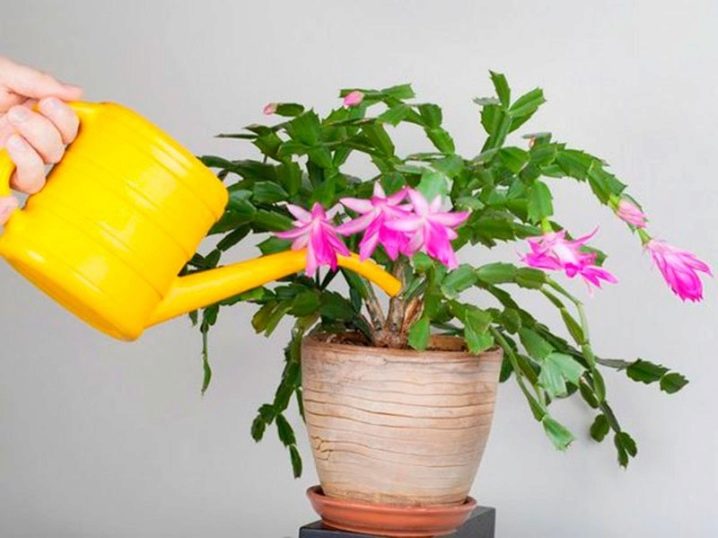
How and how to fertilize?
To feed the Decembrist, you can buy ready-made fertilizers or make them yourself at home. Specialized shops for gardeners offer a wide range of different solutions. Liquid mixes for succulents and cacti are suitable. The chemical formula NPK (nitrogen-phosphorus-potassium) is always indicated on the labels of these products. For a room "Schlumberger" the formula (10X6X8) will be ideal. Such solutions are applied to wet soil at the rate of 100 ml per 1 liter of soil or in accordance with the manufacturer's recommendations on the label.
If it is not possible to purchase ready-made mixtures, you can make a nutrient solution at home. Florists use folk remedies for fertilization.
- Boric acid is mainly used for foliar feeding. To do this, 1 g of acid is diluted in hot water, and then 1 liter of cold water is added. Spraying zygocactus with 0.1% boric mixture during flowering and budding increases the flow of sugars to the generative organs and increases flowering intensity. During fertilization, direct sunlight should be avoided so that the plant does not get burned. For irrigation, boric acid is diluted in a proportion of 1-2 grams per 10 liters of water.
- Iodine improves metabolic processes in plant tissues and is an excellent prevention of various diseases. For root feeding, it is important to strictly observe the proportions: 0.1 mg of iodine per 1 liter of water. Otherwise, the solution can burn "Schlumberger" or paint the flowers in an unpleasant yellowish color. Watering must be carried out without touching the leaves and root part.
- Banana is rich in potassium, phosphorus and calcium. To prepare a nutritious powder, the skins are washed and dried on a battery or in an oven. When the banana peel turns dark brown, grind it with a blender or coffee grinder. You can fertilize the soil in a pot with the finished powder, regularly adding small doses when watering.
- Hydrogen peroxide saturates the soil with oxygen. The chemical composition of peroxide resembles water, and houseplants react to it quite favorably. The substance suppresses the number of harmful bacteria and microorganisms, promotes the growth of the Decembrist and accelerates flowering. The solution for irrigation is prepared in the following proportion: 20 ml of hydrogen peroxide (3%) per 1 liter of water. The use of the resulting mixture is recommended no more than 1 time per week.

With the fertilization of the Decembrist, you need to be careful, you should not often water and spray the plant with various mineral compounds.
Signs of improper feeding
When feeding, it is important to understand and take into account the real needs of the plant, to choose the correct period of the procedure and the dosage of minerals. An excess of fertilizers will also negatively affect the plant, as will their absence. It is worth paying attention to certain signs of a flower with an incorrect composition of minerals in the soil, with the appearance of which it is necessary to immediately stop feeding.
- Rapid aging and yellowness indicate an excess of phosphorus.
- A peculiar burn of leaves, their death, necrosis occur with an excess of boron.
- The lack of flowering and the dark green tinge of the stem indicate an oversaturation of the substrate with nitrogen.
- A change in shape, a lighter shade and leaf lethargy signal potassium oversaturation.
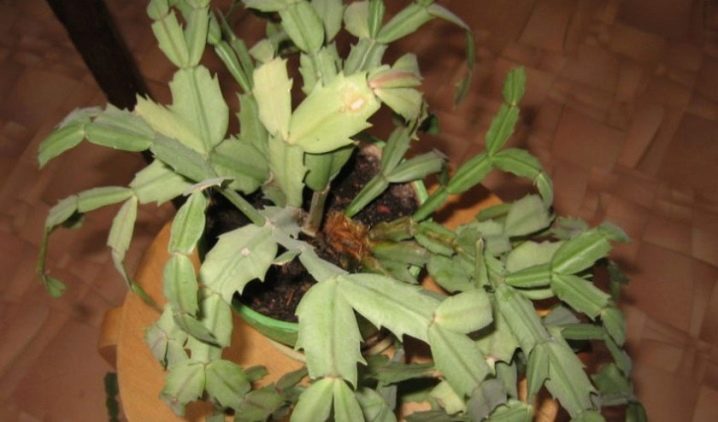























































The comment was sent successfully.